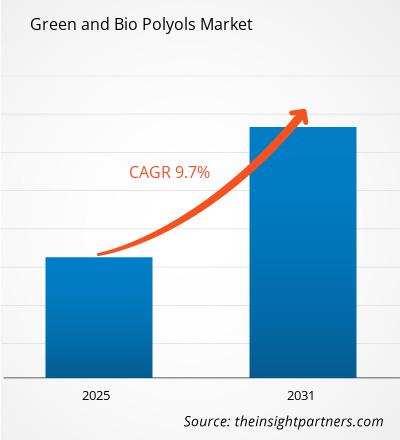グリーンおよびバイオポリオール市場は、2025年から2031年にかけて9.7%のCAGRで成長し、市場規模は2024年のXX百万米ドルから2031年にはXX百万米ドルに拡大すると予想されています。
レポートは、原材料(天然油および誘導体、スクロース、グリセリン、二酸化炭素)別にセグメント化されています。レポートはさらにタイプ(ポリエーテルポリオールおよびポリエステルポリオール)別にセグメント化されています。レポートは、用途(PUフレキシブルフォーム、CASE、およびPU硬質フォーム)別にセグメント化されています。レポートはさらに、最終用途産業(家具および寝具、建設、自動車、包装、カーペット裏地など)に基づいた分析を示しています。レポートの対象範囲は、北米、ヨーロッパ、アジア太平洋、中東およびアフリカ、南米および中米の5つの地域と、各地域の主要国をカバーしています。レポートでは、上記の分析とセグメントについて米ドルでの価値を提供しています。
レポートの目的
The Insight Partners によるレポート「グリーンおよびバイオポリオール市場」は、現在の状況と将来の成長、主な推進要因、課題、機会について説明することを目的としています。これにより、次のようなさまざまなビジネス関係者に洞察が提供されます。
- 技術プロバイダー/メーカー: 進化する市場動向を理解し、潜在的な成長機会を把握することで、情報に基づいた戦略的意思決定を行うことができます。
- 投資家: 市場の成長率、市場の財務予測、バリュー チェーン全体に存在する機会に関する包括的なトレンド分析を実施します。
- 規制機関: 市場の乱用を最小限に抑え、投資家の信頼と信用を維持し、市場の完全性と安定性を維持することを目的として、市場における政策と警察活動を規制します。
グリーンおよびバイオポリオール市場セグメンテーション原材料
- 天然油および誘導体
- スクロース
- グリセリン
- 二酸化炭素
タイプ
- ポリエーテルポリオールおよびポリエステルポリオール
レポートの一部、国レベルの分析、Excelデータパックなどを含め、スタートアップ&大学向けに特別オファーや割引もご利用いただけます(無償)
グリーンおよびバイオポリオール市場: 戦略的洞察

-
このレポートの主要な市場動向を入手してください。この無料サンプルには、市場動向から見積もりや予測に至るまでのデータ分析が含まれます。
グリーンおよびバイオポリオール市場の成長促進要因
- グリーンおよびバイオポリオールの人気が高まる:消費者と企業の環境意識の高まりにより、環境に優しい製品の需要が高まっています。グリーンおよびバイオポリオールは、従来の石油ベースのポリオールに代わるより好ましい選択肢となり、メーカーはより環境に優しくなる方法を提供します。この傾向は、特に包装および自動車分野のさまざまな業界の市場における購買決定のルールをますます決定づけています。
- 持続可能な材料に対する政府の支援:世界のほとんどの地域で、政府は基準を制定し、再生可能で持続可能な材料の使用を促進するためのインセンティブを提供します。このような政策は、企業にバイオベースのポリオールの使用を強制し、その採用により最終的にはより環境に優しい慣行への移行がスムーズになります。好意的な法律、免税措置、助成金により、あらゆる分野でバイオポリの研究開発への投資が加速しています。
- 主要産業における持続可能性:建設、家具、自動車分野における環境に優しい素材の需要の高まりは、グリーンおよびバイオポリオール市場の成長を促しています。持続可能性と環境フットプリントの削減に対する消費者の期待に応えようと努力する産業は、ますます多くのバイオベースの素材を製品ラインに取り入れており、市場の成長を促進しています。
グリーンおよびバイオポリオール市場の将来の動向
- グリーン原料と循環型経済:農業副産物や廃棄物などのグリーン原料の形での低炭素イノベーションが加速しています。これは、ポリオールの持続可能性を高めるのに効果的であるだけでなく、従来の原料への依存を減らすことにもつながります。企業は再生可能な原料を使用することで、循環型経済に貢献し、環境パフォーマンス全体を向上させることができます。
- 持続可能性と性能の両立:メーカーは、従来のポリオールに匹敵または凌駕するバイオポリオールの性能特性の向上に重点を置いています。本格的な市場統合におけるコスト競争力は規模の経済性によって決まります。このようなトレンドには、持続可能性の目標と性能、そして企業にとっての手頃な価格のバランスをとるイノベーションが必要です。
- コラボレーションがイノベーションを推進:メーカー、研究者、エンドユーザー間のコラボレーションは、グリーンおよびバイオポリオール市場における重要な発展です。バイオポリオールに関する知識の共有と新たな用途の創出という点で、イノベーションを加速させます。こうした協力関係は、優れた素材の開発と市場でのより高い受容度の獲得に役立ち、持続可能な素材セグメントの成長を促進します。
グリーンおよびバイオポリオールの市場機会
- 新興市場と成長の可能性:新興市場は、グリーンおよびバイオポリオール市場にとって大きな成長の可能性を秘めています。アジアとアフリカのほとんどの地域で工業化が急速に進んでおり、消費者の持続可能性に対する意識はますます高まっています。そのため、環境に配慮した素材や製品への需要はますます高まっています。地理的範囲の拡大と製品の多様化の余地があります。
- 多様な業界への機会:バイオポリオールは、自動車製造や消費財など、様々な分野で多様な機会を生み出しています。当社は、コーティング、接着剤、軟質フォームなどの製品処方におけるイノベーションも活用しています。こうした適応性により、企業は多様な市場に参入し、変化する消費者ニーズに対応することができます。
- リサイクルと循環型経済:バイオ由来材料のリサイクル技術は、循環型経済を可能にします。バイオポリオール製品のリサイクル性向上は、廃棄物の削減と、環境に配慮した消費者の参加率向上につながる可能性があります。さらに、このイノベーションは、材料利用における循環型経済の構築という文脈において、持続可能な生産目標を支援します。
グリーンおよびバイオポリオール市場
予測期間全体を通してグリーン・バイオポリオール市場に影響を与える地域的な動向と要因については、The Insight Partnersのアナリストが詳細に解説しています。このセクションでは、グリーン・バイオポリオール市場のセグメントと地域についても、北米、ヨーロッパ、アジア太平洋、中東・アフリカ、中南米に分けて解説しています。
グリーンおよびバイオポリオール市場レポートの範囲
| レポート属性 | 詳細 |
|---|---|
| の市場規模 2024 | US$ XX million |
| 市場規模別 2031 | US$ XX Million |
| 世界的なCAGR (2025 - 2031) | 9.7% |
| 過去データ | 2021-2023 |
| 予測期間 | 2025-2031 |
| 対象セグメント |
By 原材料
|
| 対象地域と国 |
北米
|
| 市場リーダーと主要企業の概要 |
|
グリーンおよびバイオポリオール市場のプレーヤー密度:ビジネスダイナミクスへの影響を理解する
グリーンポリオールおよびバイオポリオール市場は、消費者の嗜好の変化、技術の進歩、製品の利点に対する認知度の高まりといった要因によるエンドユーザーの需要増加に牽引され、急速に成長しています。需要の増加に伴い、企業は製品ラインナップの拡充、消費者ニーズへの対応のための革新、そして新たなトレンドの活用を進めており、これが市場の成長をさらに加速させています。

- 入手 グリーンおよびバイオポリオール市場 主要プレーヤーの概要
主なセールスポイント
- 包括的な調査範囲:本レポートは、グリーンおよびバイオポリオール市場における製品、サービス、種類、エンドユーザーの分析を包括的に網羅し、包括的な展望を提供しています。
- 専門家による分析:本レポートは、業界の専門家とアナリストの深い理解に基づいて作成されています。
- 最新情報:本レポートは、最新の情報とデータ動向を網羅しているため、ビジネスの関連性を保証します。
- カスタマイズオプション:本レポートは、特定のクライアントの要件に対応し、ビジネス戦略に適切に適合するようにカスタマイズできます。
したがって、グリーンおよびバイオポリオール市場に関する調査レポートは、業界のシナリオと成長見通しを解読し理解するための先導役となります。いくつかの妥当な懸念事項があるかもしれませんが、本レポートの全体的なメリットは、デメリットを上回る傾向があります。
- 過去2年間の分析、基準年、CAGRによる予測(7年間)
- PEST分析とSWOT分析
- 市場規模価値/数量 - 世界、地域、国
- 業界と競争環境
- Excel データセット
最新レポート
関連レポート
お客様の声
購入理由
- 情報に基づいた意思決定
- 市場動向の理解
- 競合分析
- 顧客インサイト
- 市場予測
- リスク軽減
- 戦略計画
- 投資の正当性
- 新興市場の特定
- マーケティング戦略の強化
- 業務効率の向上
- 規制動向への対応






















 無料サンプルを入手 - グリーンおよびバイオポリオール市場
無料サンプルを入手 - グリーンおよびバイオポリオール市場